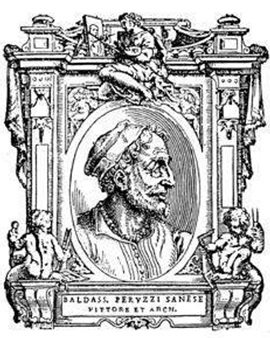


Baldassare Tommaso Peruzzi, a notable name in the history of Italian architecture and painting, spent his early years in Ancaiano, a small town near Siena, where he was born on March 7, 1481. His creative work eventually led him to the Eternal City of Rome, where he worked side by side with great masters such as Donato Bramante, Raphael and later Sangallo on the construction of the new St. Peter's Basilica. But when the storms of the Sack of Rome raged in 1527, Peruzzi returned to the familiar surroundings of his native Siena. Here he served the Republic as an architect, designing ingenious fortifications for the city as well as an impressive dam on the Bruna River near Giuncarico. Despite his deep ties to his hometown, fate finally led him back to Rome in 1535, where he died the following year. He found his final resting place in the majestic rotunda of the Pantheon, near Raphael.
Peruzzi was not only an architect, but also a gifted painter. His frescoes in the Cappella San Giovanni (Chapel of St. John the Baptist) in Siena Cathedral are a testament to his painterly talent. His sons also followed in his footsteps: Giovanni Sallustio became an architect and Onorio, after learning the craft of painting from his father, became a Dominican priest and devoted himself to the artistic decoration of the organ doors in the church of San Romano di Lucca. The design and decoration of Villa Farnesina, an architectural gem in Rome, is largely attributed to Peruzzi. The villa, originally known as Villa Chigi, is notable for its central hall, from which two wings lead off, and for the simple pilaster arrangement and decorative frieze on the exterior of the building. Some of the frescoes that adorn the villa's interiors are by Peruzzi himself. Among others, he designed the Sala delle Prospettive, in which he reinterpreted the perspective schemes of Melozzo da Forli and Mantegna.
Our art prints of Peruzzi's masterpieces allow art lovers to admire the unique aesthetic and finesse of his original works. Each art print we produce aims to reflect the same care and accuracy that Peruzzi put into his architectural designs and fresco paintings. In this way, we enable art lovers to appreciate Peruzzi's talent and contributions to the Italian Renaissance on a whole new level.

Baldassare Tommaso Peruzzi, a notable name in the history of Italian architecture and painting, spent his early years in Ancaiano, a small town near Siena, where he was born on March 7, 1481. His creative work eventually led him to the Eternal City of Rome, where he worked side by side with great masters such as Donato Bramante, Raphael and later Sangallo on the construction of the new St. Peter's Basilica. But when the storms of the Sack of Rome raged in 1527, Peruzzi returned to the familiar surroundings of his native Siena. Here he served the Republic as an architect, designing ingenious fortifications for the city as well as an impressive dam on the Bruna River near Giuncarico. Despite his deep ties to his hometown, fate finally led him back to Rome in 1535, where he died the following year. He found his final resting place in the majestic rotunda of the Pantheon, near Raphael.
Peruzzi was not only an architect, but also a gifted painter. His frescoes in the Cappella San Giovanni (Chapel of St. John the Baptist) in Siena Cathedral are a testament to his painterly talent. His sons also followed in his footsteps: Giovanni Sallustio became an architect and Onorio, after learning the craft of painting from his father, became a Dominican priest and devoted himself to the artistic decoration of the organ doors in the church of San Romano di Lucca. The design and decoration of Villa Farnesina, an architectural gem in Rome, is largely attributed to Peruzzi. The villa, originally known as Villa Chigi, is notable for its central hall, from which two wings lead off, and for the simple pilaster arrangement and decorative frieze on the exterior of the building. Some of the frescoes that adorn the villa's interiors are by Peruzzi himself. Among others, he designed the Sala delle Prospettive, in which he reinterpreted the perspective schemes of Melozzo da Forli and Mantegna.
Our art prints of Peruzzi's masterpieces allow art lovers to admire the unique aesthetic and finesse of his original works. Each art print we produce aims to reflect the same care and accuracy that Peruzzi put into his architectural designs and fresco paintings. In this way, we enable art lovers to appreciate Peruzzi's talent and contributions to the Italian Renaissance on a whole new level.
Page 1 / 1






